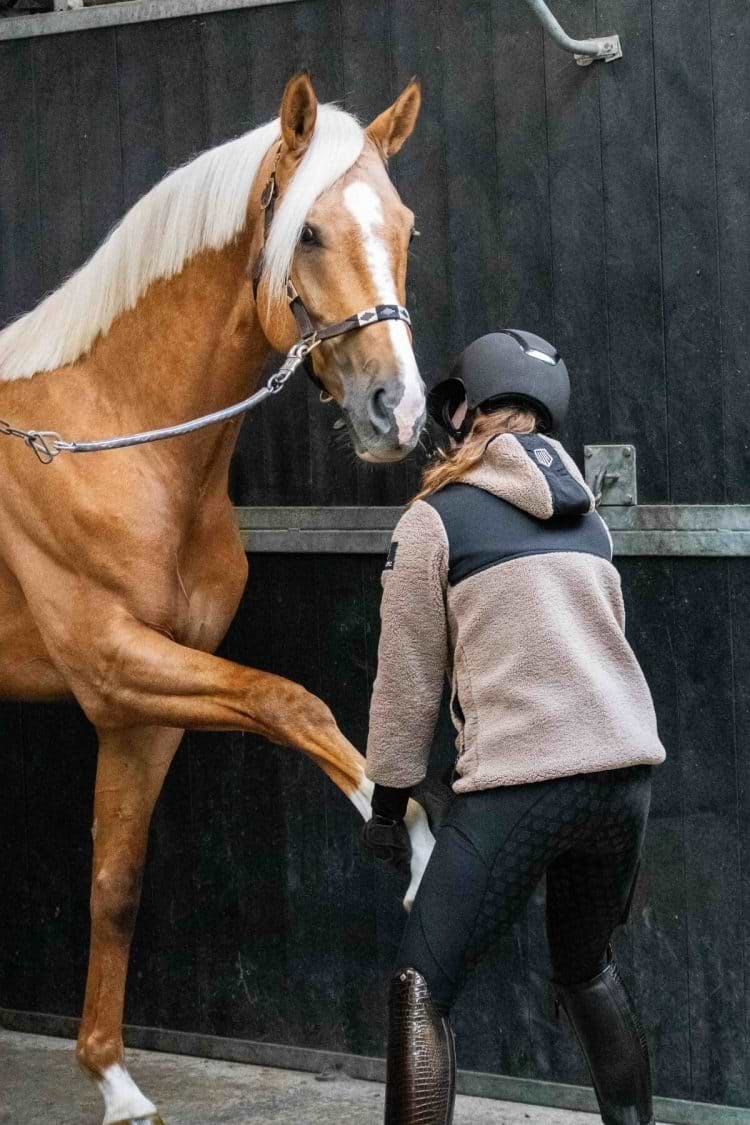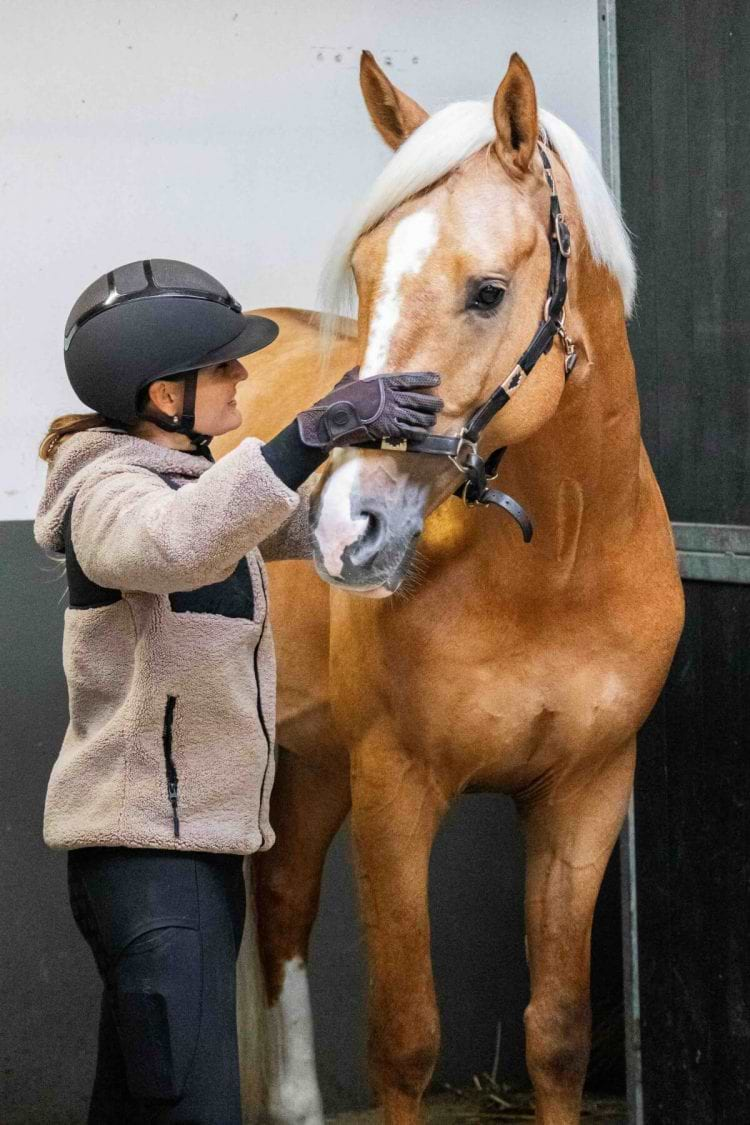Maxime Osse on
Equine Osteopathy
Equine osteopathy is a treatment that seeks to restore balance in a horse's body. Read our interview with expert Maxime Osse to learn more!
Erika
Fri 3 Nov - 23

Maxime Osse on
Equine Osteopathy
Equine osteopathy is a treatment that seeks to restore balance in a horse's body. Read our interview with expert Maxime Osse to learn more!
Erika
Fri 3 Nov - 23
Did you know that a simple accident, like tripping or getting stuck while your horse is rolling in their stall, could lead to imbalances and issues in your horse’s body? These issues could limit their range of motion or even cause pain, which ultimately leads to a tough time for the both of you. To treat – or even better, prevent – issues, there are several treatments horses can benefit from.
In this article, we shine a light on the field of equine osteopathy, with none other than professional Dutch dressage rider, human physiotherapist and equine osteopath Maxime Osse. In this interview packed with knowledge, she shares exclusive insights on the equine osteopath profession, warning signs to look out for in your horse, as well as tips on how to keep your horse healthy and balanced. Here we go!
For someone who might not know you, who is Maxime Osse?
– I'm a 30-year-old professional dressage rider and equine osteopath based in the Netherlands. I own and operate my dressage stable, focusing on training, competing, and selling dressage horses ranging from youngsters to Grand Prix level. In addition to my role as a horse osteopath, I have a background as a human physiotherapist. Seven years ago, I made the decision to fully dedicate myself to working with horses, and I've never looked back!
What made you choose physiotherapy and osteopathy as a line of work?
– Well, it's a bit of a funny story because initially, I wanted to be a veterinarian. But my vet told me pursuing that career might clash with my dressage ambitions; I simply wouldn’t have enough time. Meanwhile, I discovered alternative horse treatments like physiotherapy and osteopathy, which intrigued me. Despite dreaming of working with horses, my parents urged me to pursue a more secure career path. Since physiotherapy and osteopathy fascinated me, I chose human physiotherapy as my first study, a prerequisite before diving into horse physiotherapy or osteopathy.
What exactly is equine osteopathy?
– It's a treatment that restores balance in a horse's body, addressing various causes of imbalance. Osteopathic principles are based on the logic of anatomy, physiology, and pathology, viewing the body as a unified whole, where structures and functions are interconnected, and which has self-healing mechanisms. It’s a manual therapy that seeks to enhance mobility and function in the horse's skeleton, muscles, ligaments, joints, and organs, ultimately restoring balance.
Coming from a human physiotherapy background, why did you choose osteopathy over equine physiotherapy?
– When I was younger, I broke my arm. I compensated for this with my body which led to a small injury in the opposite shoulder muscle. I decided to get treatment for this injury and since we had a human osteopath in our neighborhood, I opted for that treatment. It was my first experience with osteopathy and the treatments helped me a lot and made me curious. Equine osteopathy required a veterinary or para-veterinary study as a prerequisite, making human physiotherapy a natural step toward my subsequent studies in equine osteopathy. During my human physiotherapy studies, I received a job offer, and working in this field showed me certain approaches' limitations for some kinds of pathologies. Influenced by my very positive experience with osteopathy as a patient, I opted for equine osteopathy. Part of my decision was driven by my fascination with the thorough examination and treatment of ALL structures, including organs.
How do veterinarians approach your job?
– Interestingly, the veterinarians I've encountered are open and very interested in equine osteopathy. It was eye-opening to find many veterinarians in my class pursuing the same study.

How do you adjust your methods when working with different types of horses, like those in dressage, show jumping, or other equestrian disciplines?
– As every horse is different and unique, it is important to adjust your methods for every horse. The different disciplines are not really relevant for my treatment. The main goal is restoring balance in the equine body. Remaining open-minded, I focus on treating what needs attention, allowing it to heal naturally.
“As they say, prevention is the best cure.”
– Maxime Osse
What signs should someone look for to determine if their horse has any issues?
– If you notice that something is different with your horse’s behavior, it is good to have a check-up. Examples could be:
If your horse shows any discomfort or you are having some issues while riding.
Symptoms like stiffness, bucking, rearing, or lameness.
If your horse is crooked, tense, or trips a lot.
Treatment can also be necessary after a trauma such as slipping or falling, walking against a stable door, hangups with a halter on, or getting stuck whilst rolling in the stable.
– But, as they say, prevention is the best cure: Detecting imbalances before discomfort arises is ideal, though not always possible. I recommend annual preventive checks with your therapist and prompt veterinarian contact for any doubts or problems. The goal is early detection and proactive care for your horse's well-being.
How much do you work as a physiotherapist/osteopath nowadays?
– While my main focus nowadays is on my dressage stable, I remain passionate about equine osteopathy. I have a dedicated group of long-term clients, and being an equine osteopath allows me to keep the horses in my own stable fit and supple. I combine training with treatments, ensuring the optimal well-being of the horses under my care.
How do your skills and knowledge from your education help you with the horses you train and work with every day? What routines do you have to keep them healthy?
– I think it is a big advantage to be able to combine both professions. I check the horses every time I give them a brush and take them out for training. This way, I can be on top of their physical condition. The findings from my examinations directly influence how I approach their training, and vice versa. Of course, it is not always possible to prevent or treat everything, but, if necessary, I then work together with the vet.
How do you handle criticism around equine osteopathy being considered alternative medicine and lacking scientific basis?
– Honestly, I rarely encounter such criticism. My experience is that both veterinarians and people generally express positive views on equine osteopathy.
What do you enjoy most about working with horses?
– I've always been around horses and being around animals in general brings me immense joy. Working with horses is a dream come true. I cherish their appreciation and the unique ways they express love.
Can you offer some advice to riders on how to keep their horses' musculoskeletal health in good shape and prevent common issues?
– I'd suggest starting with a well-tailored management plan for your horse, including consistent routines, sufficient turnout, proper feeding, balanced training, and regular check-ups. For osteopathy treatments, I recommend an annual check-up for preventive care. However, the frequency ultimately depends on your horse's individual needs.
Thank you, Maxime, we've really learnt a lot!
💡 Tip
Check out exclusive tips from physiotherapist Maxime Osse in MD Magazine, to learn what you as a rider can do to keep your body healthy, and if you could benefit from physiotherapy. Become a member and log in now!
